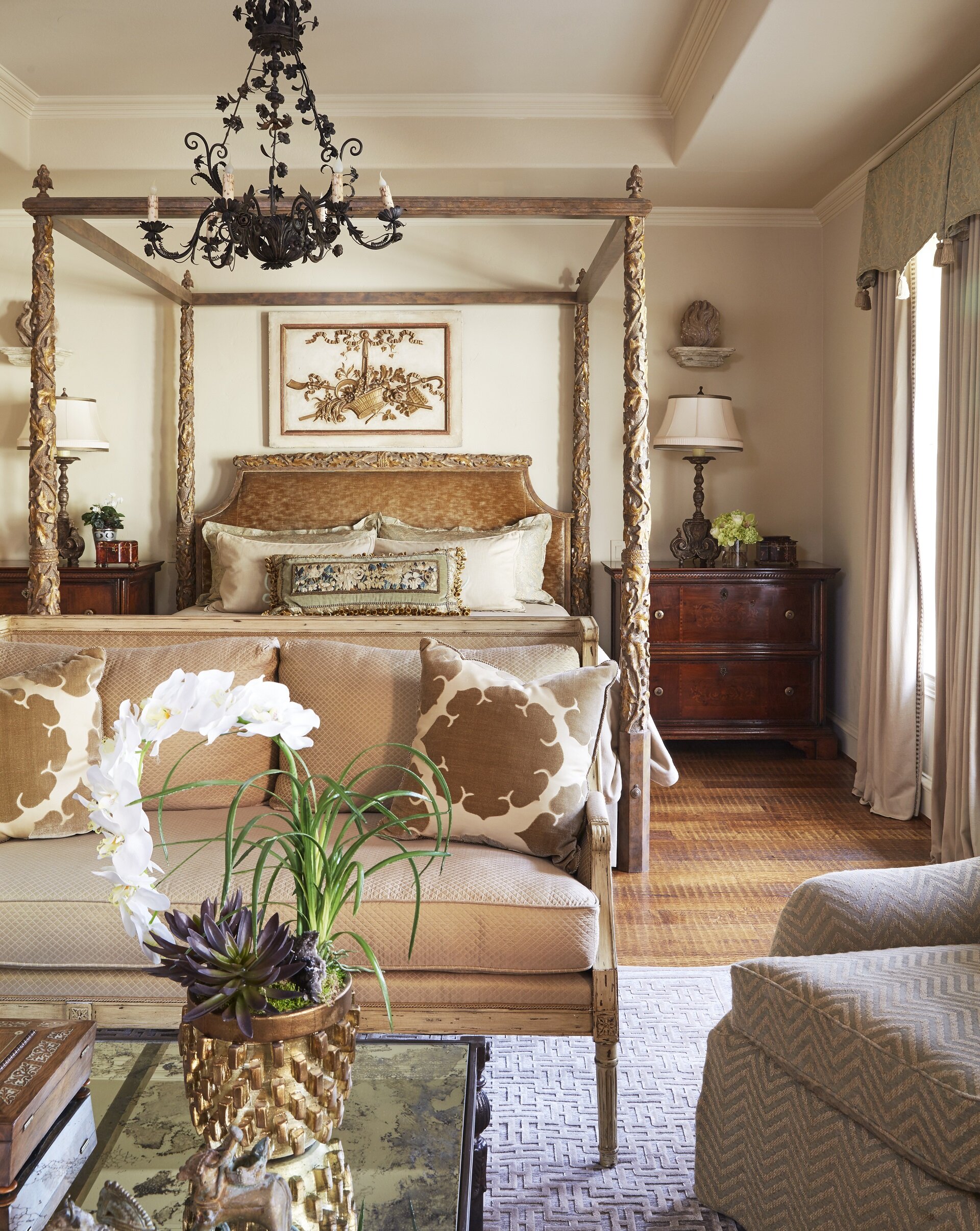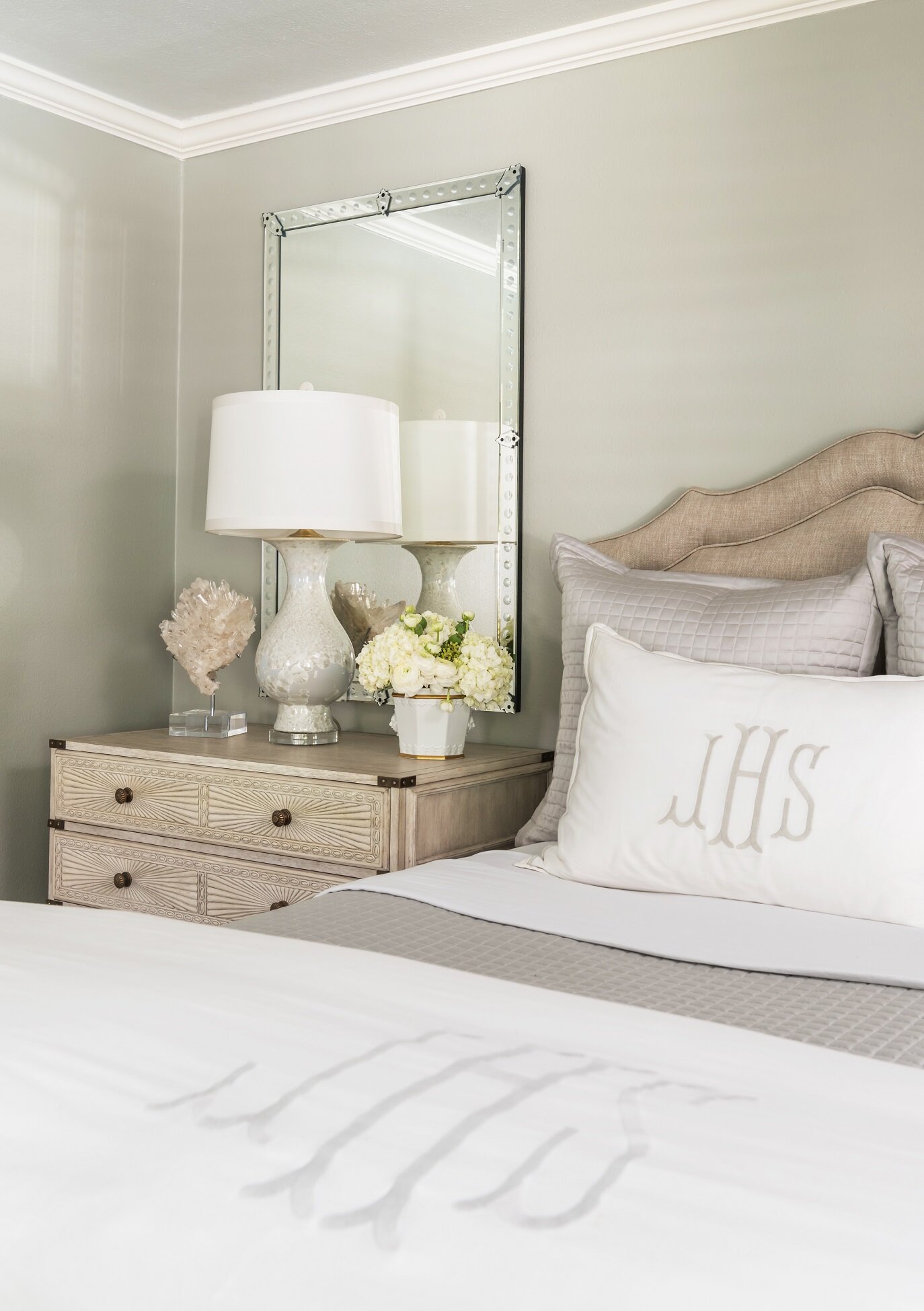Seen above is the master bedroom from a chateau we designed in University Park, Dallas.
Although there are dozens of ways to style a bed, some methods are more tried-and-true than others. If you’re looking for a way to refresh your bedding without committing a style faux-paus, you’ll want to take a look at these guidelines. In this article, I’ll cover classic formulas for making a bed as well as the most popular colors, patterns, and materials for bedding.
Foolproof Formulas for Making a Bed
The four standard size pillows in the back and smaller decorative pillow up front are just the right proportion for this queen bed.
The number and size of the pillows you should use depends on the size of your bed.
For a queen bed, you’ll need: two queen-size pillows, two sham pillows, and an accent pillow between 22 and 26 inches. For a king bed, you’ll want to use the following pillow formula: two king-size pillows, three king-sized sham pillows, and an accent pillow between 24 and 26 inches.
The stylistically safest way to arrange these is to put the pillow shams in back, your sleeping pillows in the middle, and then your accent pillows in front. Here are some alternative formulas for beds that are also very balanced:
Four sleeping pillows in back, one lumbar pillow in front
·Two sleeping pillows in back, one lumbar, and one accent pillow in front
Four sleeping pillows and two to three differently shaped and sized accent pillows in front
If you have a pretty headboard, you may want to go with fewer pillows to show it off. For lumbar pillows, consider placing a round decorative pillow in front; it’ll contrast nicely with the rectangular shape behind it.
We made sure to use lumbar pillows here so that the hand-blocked pattern on the upholstered headboard would be visible.
Duvet and Sheet Tips
Top sheets should be put in finished side down so that the sleeper can enjoy the soft texture. This way, the finished side will also be visible when you fold the banding back.
When you fold your duvet, I recommend folding it in half, and then pulling it back towards you into thirds, past the rows of pillows. Pulling it back gives the pillows more “breathing room” and creates more depth. Regardless of bed size, any blanket or quilt you put on the bed needs to be long enough that both ends could drape off the sides.
Here, the grey quilted coverlet is folded back to expose white sheets, giving more depth to the bed in this Dallas bedroom.
Choose Bedding Materials Wisely
Since the bed is the main attraction in any bedroom, it makes sense to prioritize it in your budget. Look for the highest quality bedding you can afford. That said, there is no need to break the bank on your next mattress; a good mattress topper can make even the most uncomfortable mattresses feel great. Make sure to get a mattress cover too. It helps you get the most longevity out of your mattress.
Many people change their bedding with the seasons. Percale sheets are nice and cool in the summer, flannels will keep you warm in the winter, and linen is a good in-between material for both spring and fall. Its hollow fibers trap the optimal amount of body heat to keep you warm at night while also being soft and supple.
Color and Pattern Combinations You Can’t Go Wrong With
All-white bedding is popular because it promotes a feeling of relaxation. Even when your duvet and pillows are colorful, it’s strongly recommended to choose white sheets and sleeping pillows. The white pillows and folded-down top sheet (if visible) will help break up the areas of color and give the eye a place to rest. Blue is probably the next most popular color scheme for bedding. While white is elegant and refined, blue has more of a casual and coastal feel.
White and blue is a classic color combination. It can instantly give bedding a refreshing and uplifting feel.
Love patterns? Make sure to break up the patterns in your bedding with some solid colors too so that the bedding is not too “busy.” To unite different patterns, make sure both patterns share at least one color. If you’re using a subtle tone-on-tone look for your colors and patterns, you’ll need to go in the opposite direction and introduce contrast with a variety of textures.
The busy patterns on the curtains and decorative pillow in this bedroom are balanced out by the neutral bedding.
A beautifully made bed makes a world of difference for the bedroom. Regardless of whether you want an upscale or a casual look, combining the right patterns, fabrics and colors will help you create a look that makes you (or your guest) want to dive right in.
In this master bedroom, you can see an example of a heavily-patterned, tone-on-tone bedding set.
Could the bedding sets in your home use a refresh this year? Consider bringing in an interior designer to give your bedrooms that extra ‘wow’ factor. To schedule a free consultation with Chambers Interiors, call our Dallas office at 214-651-7665 or send an email to info@chambersinteriors.com.







